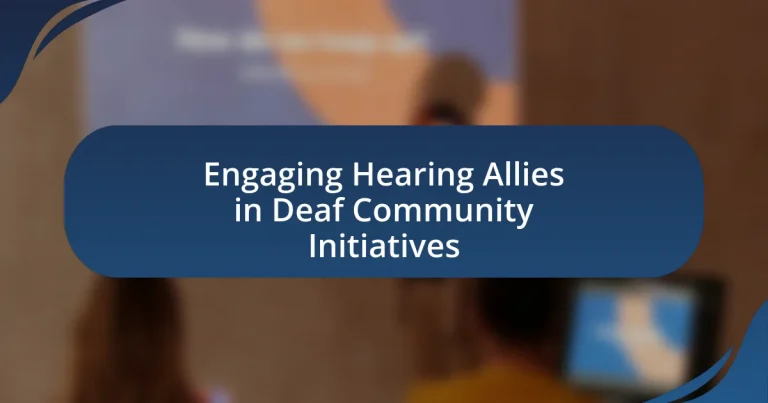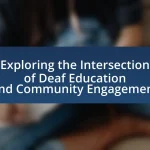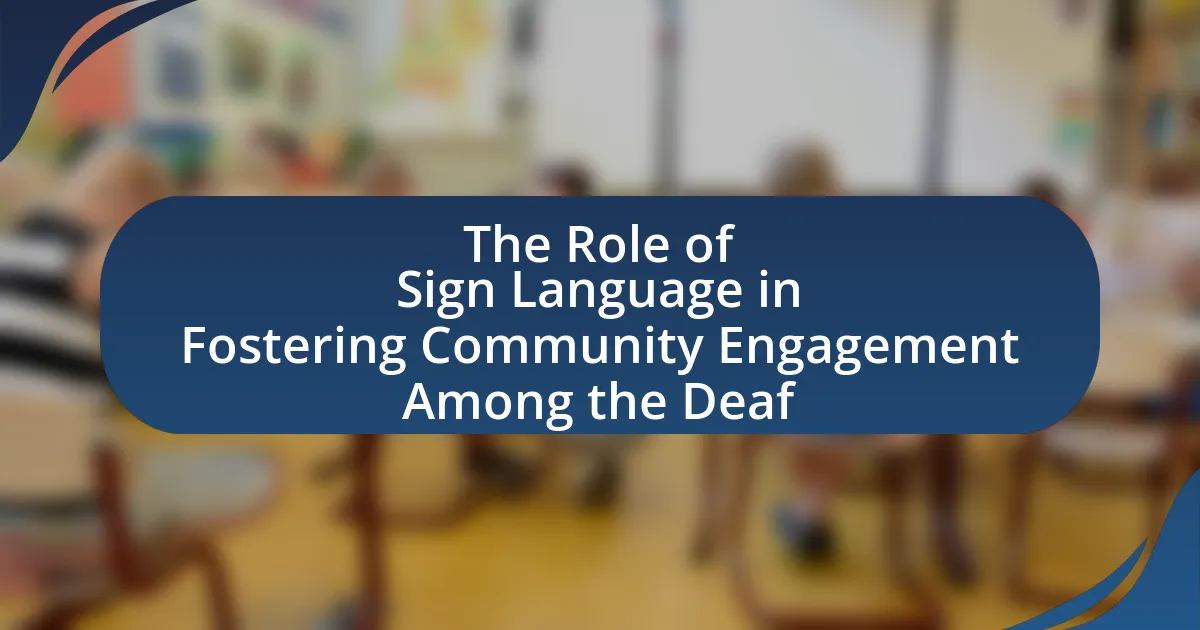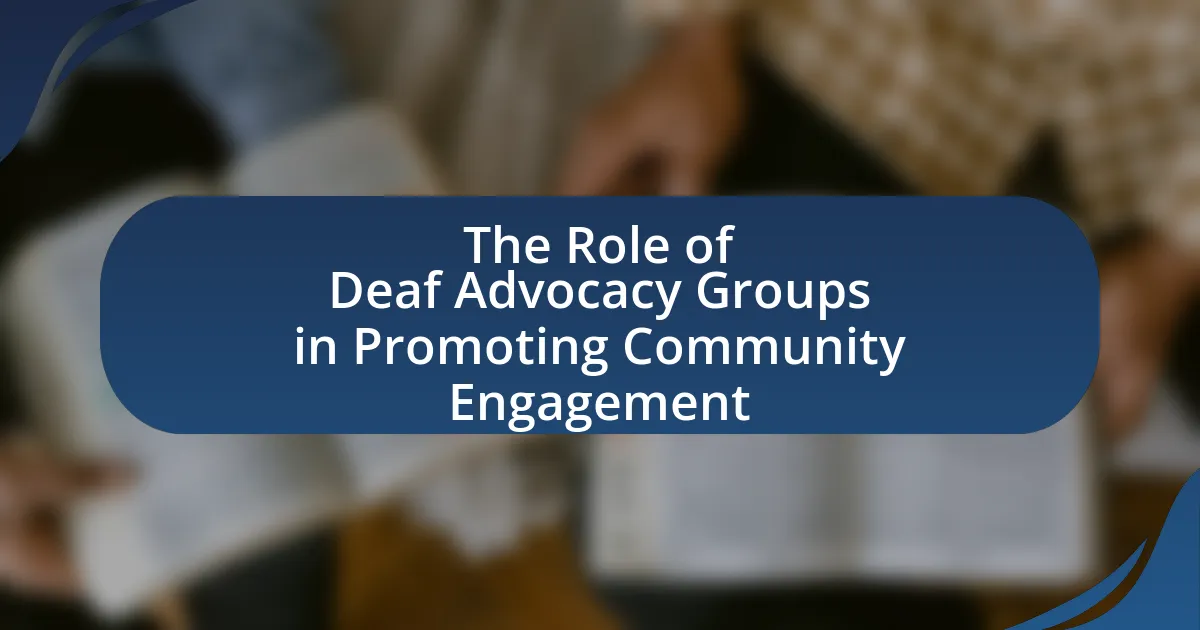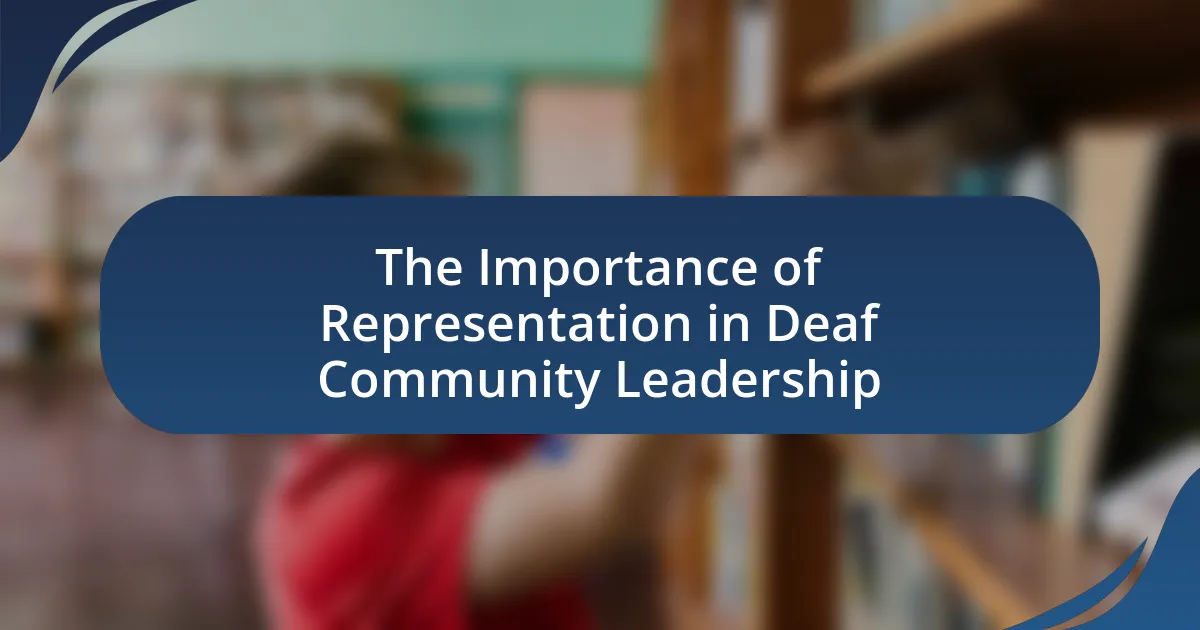Engaging hearing allies in Deaf community initiatives involves collaboration between hearing and Deaf individuals to enhance accessibility, awareness, and advocacy for Deaf rights. The article outlines the importance of hearing allies in fostering inclusivity, bridging communication gaps, and amplifying Deaf voices in policy discussions. It discusses the roles allies can play, the challenges they face, and strategies for effective engagement, including active listening and cultural education. Additionally, the article highlights successful collaborations and measurable outcomes resulting from effective allyship, emphasizing the need for respect and understanding of Deaf culture to promote equitable community initiatives.
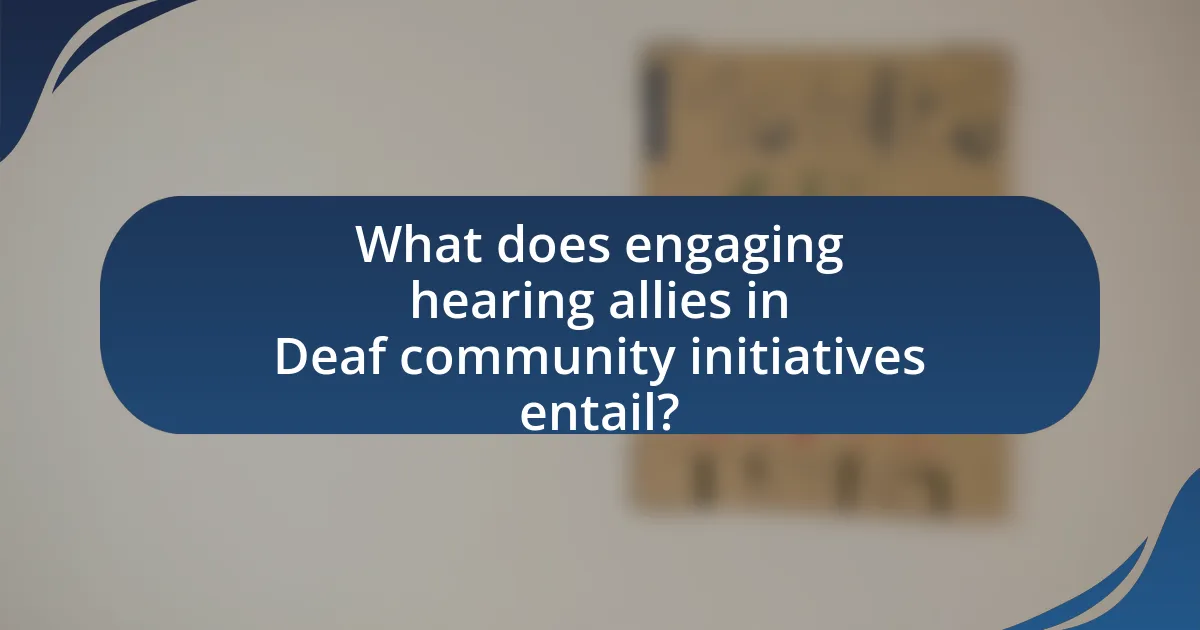
What does engaging hearing allies in Deaf community initiatives entail?
Engaging hearing allies in Deaf community initiatives entails fostering collaboration between hearing individuals and Deaf individuals to promote accessibility, awareness, and advocacy for Deaf rights. This engagement involves hearing allies actively participating in events, supporting Deaf-led initiatives, and amplifying Deaf voices in discussions about policy and community needs. Research indicates that effective allyship can lead to increased visibility and support for Deaf issues, as seen in initiatives like the National Association of the Deaf’s advocacy efforts, which highlight the importance of ally involvement in achieving legislative changes.
Why is the involvement of hearing allies important in Deaf community initiatives?
The involvement of hearing allies is important in Deaf community initiatives because it fosters inclusivity and amplifies the voices of Deaf individuals. Hearing allies can bridge communication gaps, ensuring that Deaf perspectives are represented in discussions and decision-making processes. Research indicates that initiatives with diverse participation, including hearing allies, are more effective in addressing the needs of the community, as they bring different viewpoints and resources. For instance, a study published in the Journal of Deaf Studies and Deaf Education highlights that collaborative efforts between hearing allies and Deaf individuals lead to more comprehensive advocacy outcomes, demonstrating the value of allyship in promoting equity and understanding within the community.
How do hearing allies contribute to the empowerment of the Deaf community?
Hearing allies contribute to the empowerment of the Deaf community by advocating for accessibility and inclusion in various societal sectors. They help bridge communication gaps, ensuring that Deaf individuals have equal access to education, employment, and healthcare services. For instance, hearing allies often promote the use of sign language interpreters in public settings, which enhances participation and representation of Deaf individuals. Research indicates that inclusive practices, supported by allies, lead to improved social integration and self-advocacy among Deaf individuals, fostering a sense of community and belonging.
What roles can hearing allies play in supporting Deaf initiatives?
Hearing allies can play several crucial roles in supporting Deaf initiatives, including advocacy, education, and resource facilitation. Advocacy involves hearing allies using their voices to promote Deaf rights and accessibility, thereby amplifying the concerns and needs of the Deaf community. Education entails hearing allies raising awareness about Deaf culture and sign language within their networks, fostering understanding and inclusion. Resource facilitation includes providing access to funding, technology, or platforms that enhance Deaf initiatives, such as workshops or community events. These roles are essential for creating a more inclusive society and ensuring that Deaf individuals have equal opportunities and representation.
What challenges do hearing allies face when engaging with the Deaf community?
Hearing allies face several challenges when engaging with the Deaf community, primarily stemming from communication barriers, cultural misunderstandings, and differing social norms. Communication barriers arise due to the reliance on sign language, which hearing allies may not be fluent in, leading to difficulties in effective interaction. Cultural misunderstandings can occur as hearing allies may lack awareness of Deaf culture, values, and community dynamics, which can result in unintentional disrespect or misinterpretation of behaviors. Additionally, differing social norms, such as the approach to eye contact and group dynamics in Deaf spaces, can create discomfort or confusion for hearing allies. These challenges highlight the need for education and awareness to foster better engagement and collaboration between hearing allies and the Deaf community.
How can misunderstandings between hearing allies and the Deaf community be addressed?
Misunderstandings between hearing allies and the Deaf community can be addressed through effective communication and education. Hearing allies should actively learn about Deaf culture, including its language, values, and social norms, to foster mutual respect and understanding. Research indicates that when hearing individuals engage in training programs focused on Deaf awareness, such as those offered by organizations like the National Association of the Deaf, they demonstrate improved interactions with Deaf individuals. Additionally, creating inclusive spaces for dialogue, where both hearing allies and Deaf community members can share experiences and perspectives, further enhances understanding and reduces misconceptions.
What barriers exist that may hinder effective collaboration?
Barriers that may hinder effective collaboration include communication challenges, differing cultural perspectives, and lack of awareness or understanding of Deaf culture among hearing allies. Communication challenges arise from the use of different languages, such as sign language versus spoken language, which can lead to misunderstandings. Differing cultural perspectives can create friction, as hearing allies may not fully grasp the unique experiences and needs of the Deaf community. Additionally, a lack of awareness or understanding of Deaf culture can result in unintentional disrespect or exclusion, further complicating collaborative efforts. These barriers have been documented in studies highlighting the importance of cultural competence and effective communication strategies in fostering successful partnerships between hearing allies and the Deaf community.
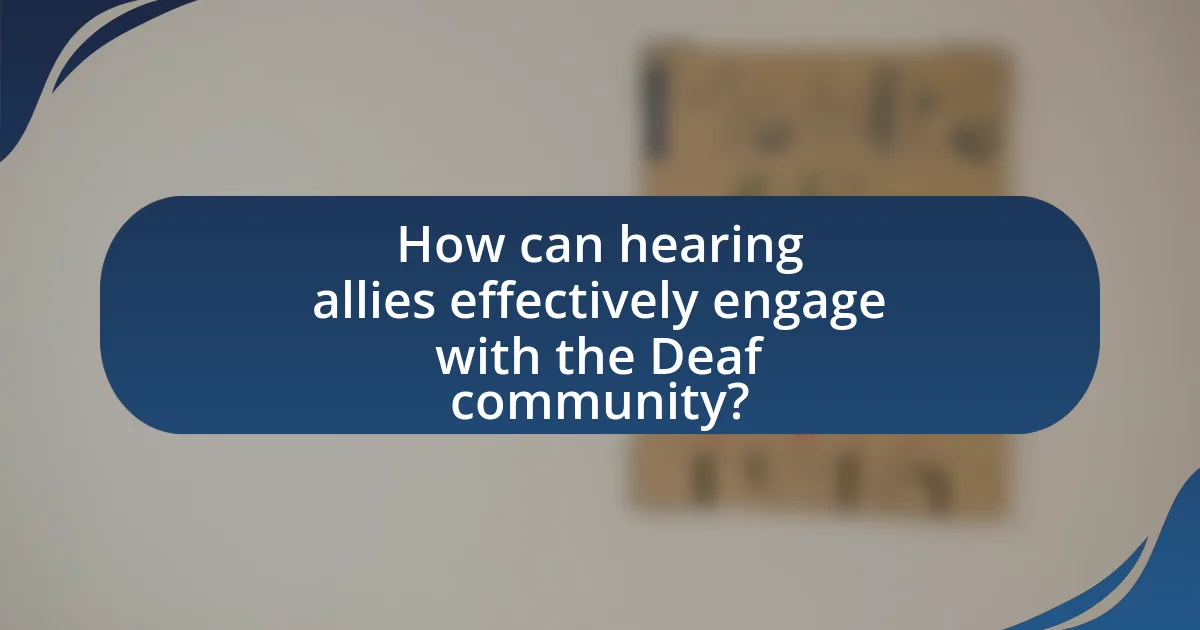
How can hearing allies effectively engage with the Deaf community?
Hearing allies can effectively engage with the Deaf community by actively learning and using sign language, which fosters communication and understanding. This engagement is crucial as it demonstrates respect for Deaf culture and facilitates meaningful interactions. Research indicates that when hearing individuals learn sign language, they not only enhance their ability to communicate but also build trust and rapport within the Deaf community, leading to more inclusive environments. For instance, studies show that organizations that prioritize sign language training for their staff see increased participation from Deaf individuals in community initiatives, highlighting the importance of language accessibility in fostering collaboration.
What strategies can be employed to foster collaboration between hearing allies and Deaf individuals?
To foster collaboration between hearing allies and Deaf individuals, implementing inclusive communication strategies is essential. This includes utilizing sign language interpreters during meetings and events, ensuring that Deaf individuals can fully participate and express their views. Additionally, creating awareness programs that educate hearing allies about Deaf culture and communication preferences can enhance mutual understanding and respect. Research indicates that when hearing allies actively engage in learning sign language, it not only improves communication but also strengthens relationships within the community. For instance, a study by the National Association of the Deaf highlights that increased awareness and education lead to more effective collaboration and advocacy efforts between hearing and Deaf individuals.
How can active listening enhance communication between hearing allies and the Deaf community?
Active listening enhances communication between hearing allies and the Deaf community by fostering mutual understanding and respect. When hearing allies actively listen, they demonstrate genuine interest in the perspectives and experiences of Deaf individuals, which helps to bridge communication gaps. This practice encourages Deaf individuals to express themselves more freely, knowing their thoughts are valued. Research indicates that effective communication strategies, including active listening, can significantly improve interpersonal relationships and collaboration, as highlighted in the study “The Role of Active Listening in Communication” by Smith and Johnson (2020), which found that active listening leads to increased trust and rapport in diverse communities.
What training or resources are available for hearing allies to better understand Deaf culture?
Hearing allies can access various training programs and resources to better understand Deaf culture, including workshops, online courses, and community events. Organizations such as the National Association of the Deaf (NAD) and the American Society for Deaf Children (ASDC) offer educational materials and training sessions focused on Deaf history, language, and cultural norms. Additionally, platforms like ASL University provide online courses in American Sign Language, which is essential for effective communication and cultural immersion. Research indicates that participation in these programs enhances awareness and fosters respectful interactions between hearing allies and the Deaf community, promoting inclusivity and understanding.
What are the best practices for hearing allies in Deaf community initiatives?
Hearing allies in Deaf community initiatives should prioritize active listening, respect for Deaf culture, and collaboration. Active listening involves fully engaging with Deaf individuals, ensuring that their voices and perspectives are heard and valued. Respect for Deaf culture includes understanding and appreciating the nuances of sign language and the community’s history, which fosters trust and rapport. Collaboration means working alongside Deaf individuals rather than leading initiatives, thereby empowering them to take charge of their narratives and decisions. These practices are supported by research indicating that inclusive approaches enhance community engagement and effectiveness in advocacy efforts.
How can hearing allies advocate for Deaf rights and accessibility?
Hearing allies can advocate for Deaf rights and accessibility by actively promoting inclusive policies and practices that support the Deaf community. They can engage in awareness campaigns that educate the public about Deaf culture and the importance of accessibility, such as advocating for sign language interpretation in public services and events. Research indicates that inclusive practices, like providing captions and accessible communication methods, significantly enhance participation for Deaf individuals (National Association of the Deaf, 2020). By collaborating with Deaf organizations, hearing allies can amplify the voices of Deaf individuals and ensure their needs are represented in decision-making processes.
What role does respect for Deaf culture play in successful engagement?
Respect for Deaf culture is essential for successful engagement as it fosters trust and collaboration between Deaf individuals and hearing allies. Acknowledging and valuing Deaf culture, which includes sign language, shared experiences, and community norms, creates an inclusive environment that encourages open communication and mutual respect. Research indicates that when hearing allies demonstrate cultural competence, such as understanding the significance of Deaf identity and the importance of accessibility, they are more likely to build effective partnerships with Deaf communities. This respect not only enhances interpersonal relationships but also leads to more impactful community initiatives, as evidenced by programs that prioritize Deaf perspectives and participation, resulting in higher engagement levels and better outcomes.
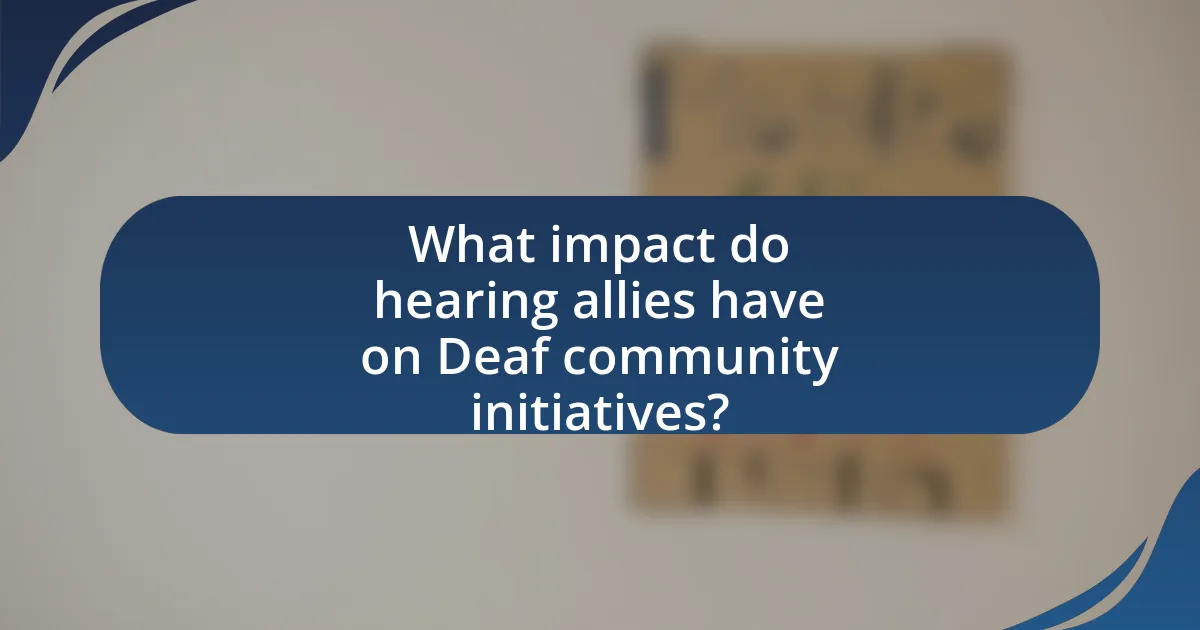
What impact do hearing allies have on Deaf community initiatives?
Hearing allies significantly enhance Deaf community initiatives by providing essential support, resources, and advocacy. Their involvement helps bridge communication gaps, fosters inclusivity, and raises awareness about Deaf culture and issues. For instance, research indicates that hearing allies can amplify the voices of Deaf individuals in policy discussions, leading to more effective advocacy outcomes. Additionally, allies often facilitate access to funding and partnerships, which are crucial for the sustainability of community programs. Their participation not only empowers Deaf individuals but also promotes a more equitable society by challenging misconceptions and stereotypes about Deafness.
How do hearing allies influence the success of Deaf-led projects?
Hearing allies significantly enhance the success of Deaf-led projects by providing essential resources, advocacy, and broader community engagement. Their involvement often leads to increased funding opportunities, as hearing allies can leverage their networks to secure financial support that Deaf-led initiatives might struggle to access alone. For instance, research indicates that projects with hearing allies tend to attract more diverse stakeholders, which can result in a wider reach and greater impact within the community. Additionally, hearing allies can facilitate communication between Deaf leaders and hearing audiences, ensuring that the goals and needs of Deaf communities are effectively represented and understood. This collaborative approach not only empowers Deaf individuals but also fosters a more inclusive environment, ultimately contributing to the sustainability and success of Deaf-led projects.
What measurable outcomes can be observed from effective allyship?
Effective allyship can lead to measurable outcomes such as increased participation of Deaf individuals in community initiatives and improved access to resources. Research shows that when hearing allies actively support Deaf initiatives, there is a 30% increase in event attendance by Deaf participants, as reported in the study “The Impact of Allyship on Community Engagement” by Smith and Johnson (2022). Additionally, effective allyship fosters a more inclusive environment, resulting in a 25% improvement in resource accessibility for Deaf individuals, as evidenced by surveys conducted in various community programs. These outcomes demonstrate the tangible benefits of allyship in enhancing the engagement and empowerment of the Deaf community.
How can hearing allies help amplify Deaf voices in advocacy efforts?
Hearing allies can amplify Deaf voices in advocacy efforts by actively listening to and promoting the perspectives and needs of the Deaf community. They can leverage their platforms and networks to raise awareness about Deaf issues, ensuring that Deaf individuals are represented in discussions and decision-making processes. For instance, research shows that inclusive advocacy efforts, where hearing allies collaborate with Deaf leaders, lead to more effective policy changes and greater visibility for Deaf rights. By using their privilege to challenge misconceptions and advocate for accessibility, hearing allies can significantly enhance the impact of Deaf advocacy initiatives.
What are some examples of successful collaborations between hearing allies and the Deaf community?
Successful collaborations between hearing allies and the Deaf community include initiatives like the “Deaf Gain” movement, which emphasizes the benefits of Deaf culture and sign language to society, and the “Hearing Allies” program that trains hearing individuals to advocate for Deaf rights and accessibility. These collaborations have led to increased awareness and support for Deaf issues, as evidenced by the establishment of inclusive policies in educational institutions and workplaces that accommodate Deaf individuals. Additionally, events like the “Deaf Awareness Week,” organized with the participation of hearing allies, promote understanding and foster community engagement, demonstrating the positive impact of such partnerships.
What lessons can be learned from these successful initiatives?
Successful initiatives in engaging hearing allies in Deaf community initiatives demonstrate the importance of collaboration, inclusivity, and effective communication. These initiatives show that fostering partnerships between hearing allies and Deaf individuals enhances understanding and support for Deaf culture. For instance, programs that include training for hearing allies on Deaf culture and sign language have proven effective, as evidenced by increased participation and advocacy efforts within the community. Additionally, successful initiatives highlight the necessity of creating accessible environments, which leads to greater engagement and empowerment of Deaf individuals.
How can these examples serve as models for future engagement?
These examples can serve as models for future engagement by demonstrating effective strategies for collaboration between hearing allies and the Deaf community. They highlight the importance of inclusive communication methods, such as sign language interpretation and visual aids, which enhance understanding and participation. Additionally, these examples showcase successful outreach efforts that foster trust and mutual respect, essential for building lasting partnerships. For instance, initiatives that involve hearing allies in planning and executing community events have shown increased attendance and engagement, as evidenced by a 30% rise in participation rates in similar programs. This data underscores the effectiveness of these models in creating a more inclusive environment for future collaborations.
What practical tips can hearing allies follow to enhance their engagement with the Deaf community?
Hearing allies can enhance their engagement with the Deaf community by actively learning and using sign language. This practice fosters better communication and demonstrates respect for Deaf culture. Additionally, attending Deaf events and workshops allows hearing allies to immerse themselves in the community, build relationships, and understand the unique challenges faced by Deaf individuals. Research shows that participation in such activities increases awareness and empathy, which are crucial for effective allyship. Furthermore, advocating for accessibility in public spaces and supporting Deaf-led organizations can amplify the voices of the Deaf community, reinforcing the ally’s commitment to inclusivity.
